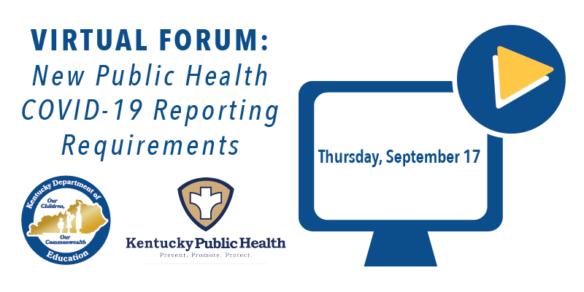
- The Kentucky COVID-19 School Re-entry Metric assumes the statewide positive test rate remains below 6% and hospitals are not nearing capacity.
- At the conclusion of Dr. Steven Stack’s presentation, he and other officials on the call fielded questions from the education stakeholders.
By Jacob Perkins
Jacob.perkins@education.ky.gov
Nearly 100 people tuned in to the Kentucky Department of Education’s (KDE) virtual forum on Sept. 17 to learn more about the Department for Public Health’s new four-color COVID-19 decision-making metric for school officials.
Lt. Gov. Jacqueline Coleman said she felt it was important to provide this additional opportunity to Kentucky’s education stakeholders so they could hear firsthand about the COVID-19 Mode of Instruction Metrics for K-12 Education, as well as have their questions answered by health experts.
“Lots of different schools are in lots of different places right now,” said Coleman. “We want to be able to communicate this with everybody in the education community.”
The virtual forum was the third opportunity for the public to hear about the metric, the first being Gov. Andy Beshear’s Sept. 14 afternoon press briefing and the second during the Sept. 15 Special Superintendents’ Webcast.
DPH Commissioner Dr. Steven Stack said if the state positivity rate spikes or hospitals are nearing capacity, the state could make additional recommendations for closing school buildings to in-person classes. But as long as the state’s rate stands at less than 6%, the metric will help school officials make decisions about whether to hold in-person instruction and other activities, he said.
As of Sept. 17, the state’s positive test rate stood at 3.82%. The state positivity rate and a map of incidence by county can be found at www.kycovid19.ky.gov.
“We want people to be informed,” Stack said. “We want people to have tools to make decisions to support local control.”
Decisions on school instruction for each coming week should be based on the color level at 8 p.m. ET each Thursday.
The color-coded system recommends specific mitigation measures based on levels of disease transmission. The four levels are:
- Green, with fewer than one case per 100,000 county residents, means schools can hold either in-person or remote classes as long as schools are following the Healthy at School guidance. Gov. Beshear’s guidance on group gatherings and other standard precautions still must be followed. Sports may resume if Kentucky High School Athletic Association (KHSAA) guidelines are followed.
- Yellow, with 9.9 or fewer cases per 100,000 people, also allows in-person or remote learning and sports, but with heightened mitigation steps as coordinated by local officials, school administrators and public health leaders.
- Orange, with 24.9 or fewer cases per 100,000, means schools should take into account a variety of factors to determine if they should move to remote learning exclusively. Sports still would be allowed, but there must be strict adherence to health guidelines. Small groups of students may be allowed into schools for targeted services.
- Red, for more than 25 cases per 100,000, means schools should move the following week to all-virtual instruction. Sports and all extracurricular activities must be suspended. Only essential staff should regularly be in school buildings, still adhering to Healthy at School guidance. Essential student support services, such as providing meals, should continue. Small groups of students can be allowed in schools for targeted services. All these measures should remain in effect until the community returns to yellow status at a future Thursday decision point.
Just because a school is in the green or yellow level does not mean they can be lax on the safety expectations outlined in the flagship Healthy at School guidance document, said Dr. Connie White, DPH deputy commissioner.
“The way you’re going to stay green or yellow is by continuing the masking and the social-distancing,” she said. “You want to continue doing those things and protect those faculty, staff and students in your community because by protecting them, you’re protecting all of the other people in your community.”
New Emergency Regulation
Also discussed during the virtual forum was the new emergency administrative regulation from DPH, signed by Beshear, which requires those responsible for students – parents, guardians or other caregivers – to notify their child’s schools within 24 hours if a student tests positive for COVID-19.
The regulation builds on the existing statute that requires reporting of infectious disease to add the specific requirement of reporting COVID-19.
The rapid-reporting requirement gives local school officials real-time data they can use to make decisions, Stack said.
Schools are required to notify DPH each school day of the number of students and school personnel who test positive for COVID-19.
The results that school districts report will be posted to an online dashboard, which can be filtered by county, district or specific school, Stack said.
“We have the belief that (districts) will report in good faith,” he said, though noting that there will be discrepancies between their quick daily reports and the verified cases compiled in DPH’s K-12 public health report.
“It is not my intention to have schools unfairly criticized where there are minor variances that are not material and are not really influencing the quality of the data overall,” Stack added.
Community Questions
After Stack’s presentation, he and other officials on the call fielded questions from the education stakeholders.
One person asked if the color-coded metric and district reporting were requirements or recommendations from the state.
The Kentucky COVID-19 School Re-entry Metric is guidance and designed for districts to use when determining the best learning model for its students, said Commissioner of Education Jason Glass.
“That is not a requirement, it is a recommendation,” he said. “It is intended to provide guidance to school district decision-makers and to communities on what learning model is most appropriate for them.”
The reporting system, on the other hand, is a requirement and districts must begin to self-report the positive cases of their students and staff on Sept. 28, said Glass.
Asked if both the school re-entry metric and reporting system still will be implemented when a vaccine is offered to the public, Stack said for the average American, a vaccine will not be available before the summer of 2021.
“This entire academic year is going to be impacted by coronavirus,” he said. “The sooner we accept that reality, the sooner we can get over the preventable frustrations and then deal with the frustrations that inevitably remain.”
MORE INFO …
- KDE’s COVID-19 webpage
- KDE’s COVID-19 Reopening Guidance webpage
- Kentucky COVID-19 Hotline (800) 722-5725




Leave A Comment